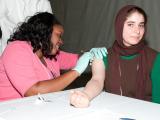Dec 16, 2011 (CIDRAP News) – Flu activity remained low in the Northern Hemisphere last week, with only a few countries, such as Costa Rica and Cameroon, reporting spikes in the number of cases, the World Health Organization (WHO) said today.
Costa Rica is the only tropical country in the Americas to report increasing numbers of cases, which are primarily influenza A/H3N2, the WHO said.
Another hot spot is Cameroon, where H3N2 infections seem to be peaking. The WHO said Cameroon's rise in H3N2 was preceded by an increasing number of 2009 H1N1 infections, which peaked in early November.
Tropical parts of Asia are reporting localized areas of transmission, with India citing areas of influenza B circulation and Laos reporting H3N2 transmission.
In temperate parts of South America, Australia, and New Zealand, flu activity has returned to inter-seasonal levels, the WHO said. However, as was true to last year, Australia is reporting persistent low-level H3N2 and influenza B transmission.
Flu levels remained low in the Northern Hemisphere's temperate countries, with only sporadic activity reported in Canada, the United States, and some European countries.
In an accompanying virological update, the WHO said flu detections were sporadic in most parts of the world, with H3N2 as the predominant strain.
Markers of flu activity in the United States remained low, with doctor's visits for flu-like illnesses below the national baseline, according to an update today from the Centers for Disease Control and Prevention (CDC). The proportion of deaths from pneumonia and flu dipped slightly, and no pediatric deaths from the disease were reported.
The percentage of respiratory samples that tested positive for flu rose slightly to 1.9%, from 1.5% last week, according to the CDC.
No states reported widespread or regional flu spread, though two more states reported local activity last week, bringing that total to three states: Alabama, Colorado, and Virginia.
The European Centre for Disease Prevention and Control (ECDC) said today that patterns seen in the temperate Southern Hemisphere's 2011 flu season might provide some clues about what Europe can expect. It said 2009 H1N1 and influenza B viruses dominated, with the proportion varying between and within countries. Circulation of H3N2 viruses was also seen, it noted. The ECDC published its full assessment of the Southern Hemisphere's flu season and its possible impact on Europe yesterday in Eurosurveillance.
In a weekly surveillance report today, the ECDC said there is no evidence of sustained flu transmission, which means annual flu epidemics haven't started. Only the Netherlands reported local spread, with Belgium, the Czech Republic, Estonia, France, Iceland, Norway, Slovenia, Spain, Sweden and Scotland reporting sporadic activity.
See also:
Dec 16 WHO global flu update
Dec 16 WHO virological update
Dec 16 CDC weekly flu update
Dec 16 ECDC press release
Dec 15 Eurosurveillance report
Dec 15 ECDC weekly flu surveillance report

















